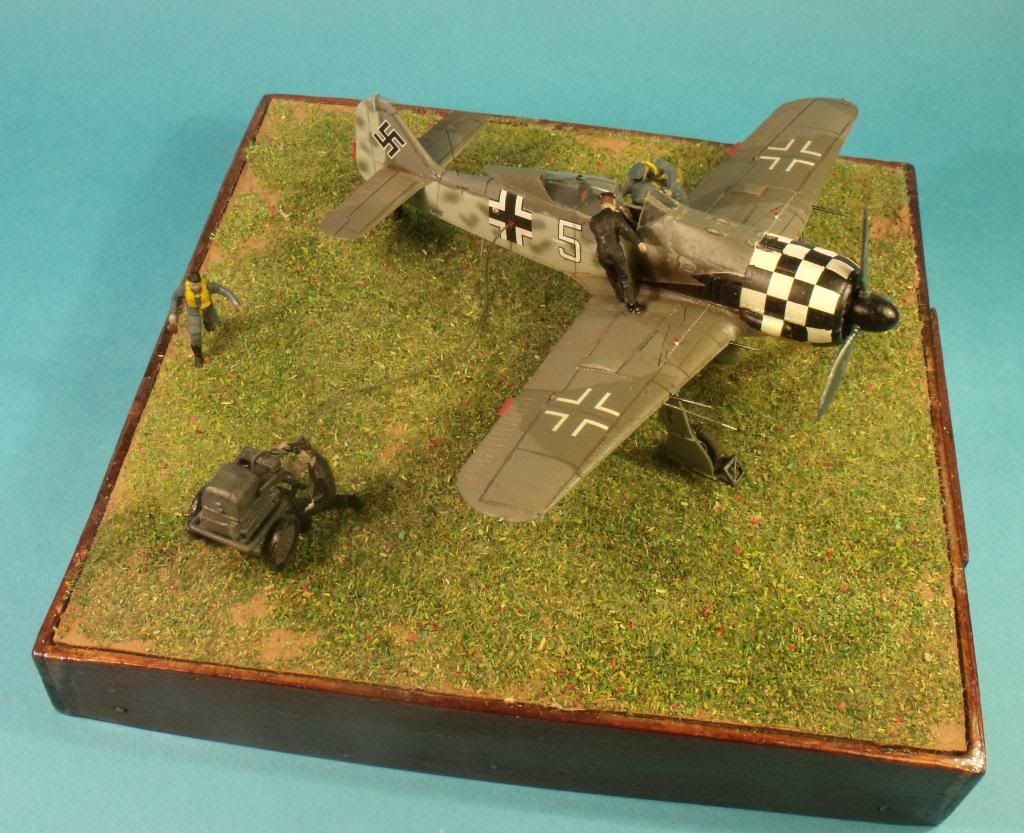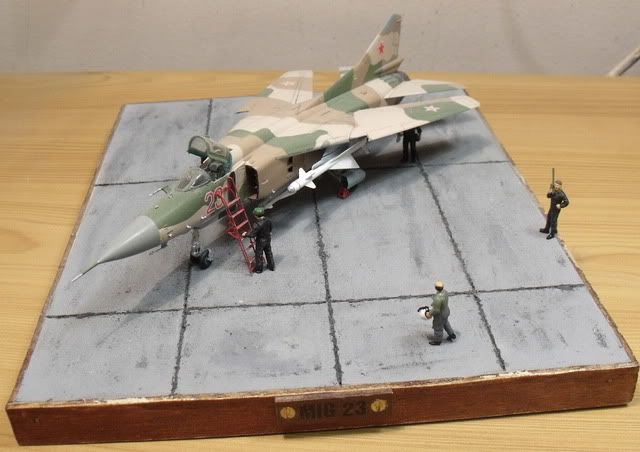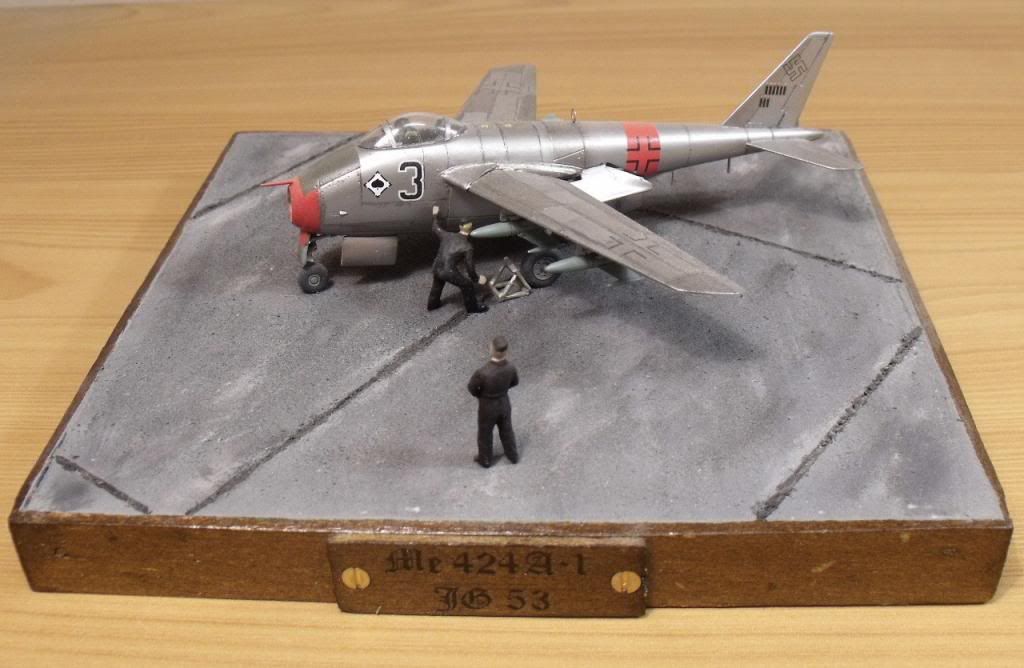Aircraft dio base.
During my last few aircraft builds, I have had some nice comments regarding my bases. So I thought I would post a little tut on how to make a pretty simple base. The ones I make are for 72nd aircraft, but with a couple of small tweaks, this would work for other scales.
Firstly, the materials. For the base I use a piece of wood, I usually use off cut of chipboard that I may have spare, or old furniture that I just cut to size. I have loads of old bit from wardrobes and work tops in the shed. For aircraft bases, I try to got for something about 2cm thick. Next to the base is a strip of balsa that I use for the surround. I have a selection of these in different thicknesses and they will do for 3 or 4 of the smaller bases.

And here are the materials for the ground work. On the left, there's Celluclay, acrylic paints and scatter materials for the grass. Celluclay can be a bit tricky to use, and I am finding it hard to find at the moment. I know others use different materials for ground work.
On the right is some cardboard, this is for the concrete. For 72nd scale, I find this ideal and readily available. I use cardboard with a rough surface that you find on the inside of model box lids or the out side of the bottom part of the box. And if you use Eduard PE sets, the cardboard in those is ideal. For other scales, you might need something different, I believe sanding paper is useful for larger scales.

Now, for making the base. This one has both grass and concrete. The approach is the same for either a complete grass base or concrete base, just missing out the obvious steps.
Firstly, I put the surround around the base, using the balsa, doing the sides first and then the front and back. The surround is a bit higher than the base, about 2mm or so.


Next, I add the cardboard for the concrete. If you can use one large piece, then great. If you use smaller pieces, try to cut them to the size of the concrete panels. Different country's use different size and sometimes shapes of panels. Try and find a pick of the aircraft you building and you can work out the rough size. Then you can just use the same size for ant other aircraft in that country. For WW2 German, I do panels 14cm x 8cm. If you use one large piece, then score lines in at the required distance.
The cardboard is stuck down with white glue.


Once the cardboard is down, sand the surround down to the level of the cardboard. Where the grass is going to be, I also sand this, but so its irregular and still leaving a bit above the base.
Then I stain and varnish the surround. I prefer to use a separate stain to those coloured varnishes.


Once this is all dry, I mask the surround and paint the concrete. I do this with acrylic paints, starting with a light grey, then all in one sessions, going over with various shades of grey, dark here, light there. Its all done randomly.


After this, I go over it with oil paints. Again going over it in various shades of grey. Once this is dry, I do the same thing again with pastel chalks.


Next up is the soft ground. This starts with Celluclay. The trick with this is not to have to much water in it. It does shrink, and the more water in there, the more it shrinks. Make a little more than you think you will need. In the bowel or what ever you mix it in, it will stay soft for a few days, long enough to see any shrinkage and top up.
I used to paint Celluclay after it was dry, but that's a real pain. So now I mix the paint into the mix. Keep in mind where your scene is set. I don't get to uptight about it, but for Northern Europe, I would do it darker than say the Med.


Next up is the grass. You can buy the grass mats, but I am not keen on these. They look like well kept bowling greens. If your doing a modern scene, or a WW2 heavy bomber, where they wouldn't go on the grass, they might be ok. But for a lot of WW2 aircraft, they operated from grass. Not only does the aircraft taxy on it, but there's trucks, ground equipment and men on it.
I have read comments about scatter grass saying its not very realistic. But I like it. I use a mix of lengths, keeping scale in mind, and colours, keeping the location in mind, and scatter them onto white glue.


And that's about it. One final thing is a nameplate if you so wish. I used to use a piece of balsa, stained the same as the surround, and use rub off letters. But this took ages and I often couldn't get them all level. So after reading a couple of threads, I have now changed to printing off nameplates on card, then stuck to a piece of stained balsa and screwed to the base.

All that's left to do now is add your aircraft and other items.
I changed the nameplate when I realised I had put the Staffel on it.

The base can be built in about a week. But most of that is drying time for the wood and celluclay. Time spent on it is about 3 or 4 hours. An all grass base takes a bit longer than all concrete. The longest session was about 30mins. I start my bases once I get to a stage when I have to start leaving the model to one side to dry. I am to have the base all done and ready by the time the aircraft is done, so it can go straight on.
Here's a few other example showing all grass and all concrete bases. The first is an example of what can go wrong with Celluclay. I tried to rush it and added the grass before the celluclay was dry. It then shrank and I didn't want to risk doing more harm than good. So there's a gap of about 1mm all the way around.
These have my older style of nameplate which I used upto my current build. these are going to be changed.

I have ben using this stuff for years so should have known better.
This one came off much better.

And here's a couple of concrete ones.


I hope some of you find this useful. If anyone has any tips, or ideas for different materials, please feel free to add them.
Thanks for looking.